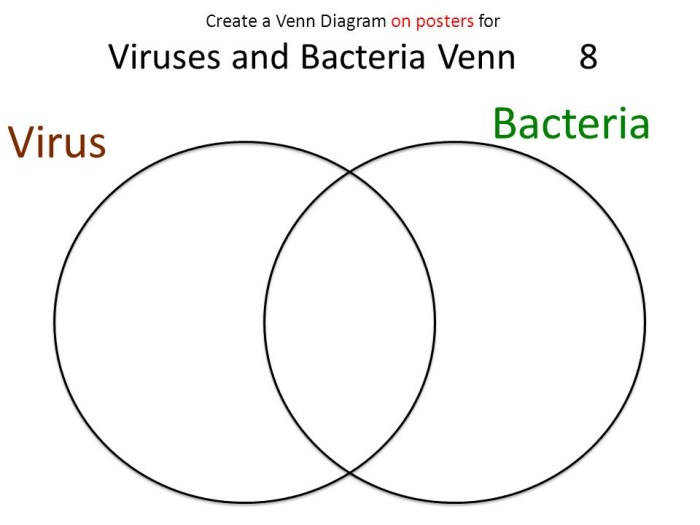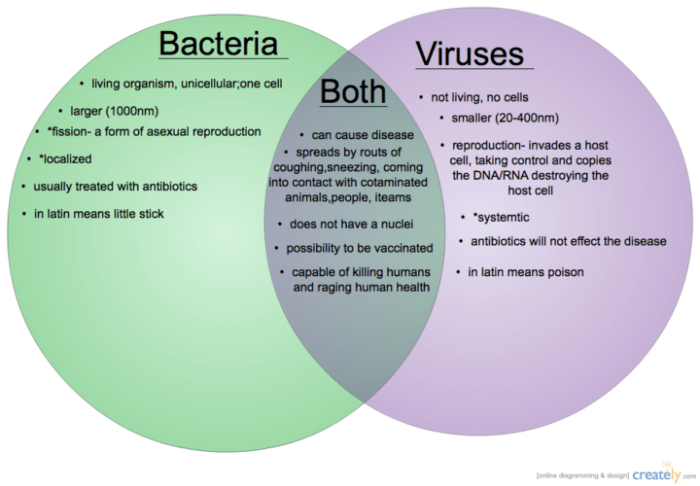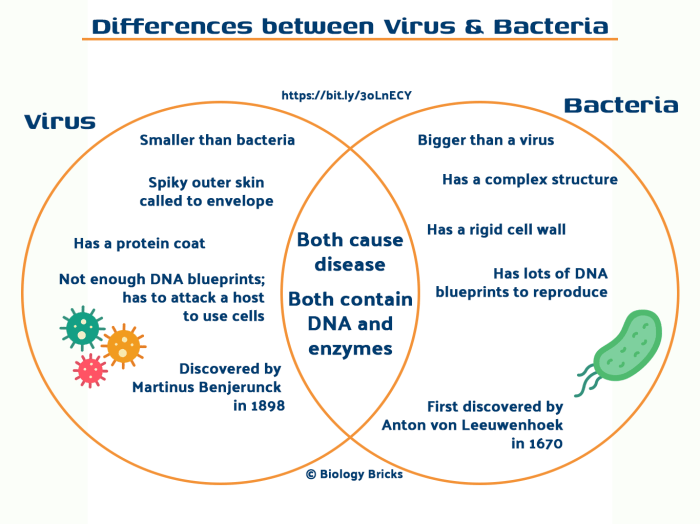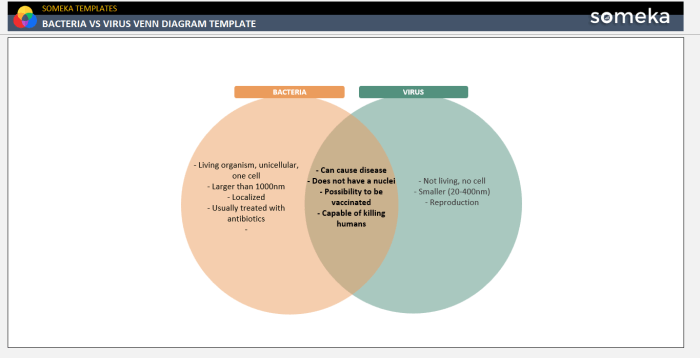Venn diagram bacteria and virus – Unveiling the intricate relationship between bacteria and viruses, this comprehensive analysis employs a Venn diagram to delineate their shared and distinct characteristics, shedding light on their roles in disease and treatment.
Definitions
Bacteria and viruses are both microorganisms, but they have distinct characteristics and properties. Bacteria are single-celled organisms that can survive in a wide range of environments, while viruses are acellular entities that can only replicate inside the cells of other organisms.
Bacteria are prokaryotes, meaning they lack a nucleus or other membrane-bound organelles. They typically have a cell wall, a plasma membrane, and a cytoplasm that contains ribosomes and DNA. Bacteria can be classified into two main groups: Gram-positive bacteria, which have a thick cell wall, and Gram-negative bacteria, which have a thin cell wall.
Viruses are not considered cells because they lack the necessary components to carry out metabolism and reproduce independently. Instead, viruses consist of a protein coat that encloses a core of genetic material, either DNA or RNA. Viruses can only replicate inside the cells of other organisms, which are known as host cells.
Distinguishing Features
- Size:Bacteria are typically larger than viruses, with a size range of 0.5-5 micrometers, while viruses are much smaller, with a size range of 20-300 nanometers.
- Structure:Bacteria are prokaryotic cells with a cell wall, plasma membrane, cytoplasm, and DNA, while viruses are acellular entities with a protein coat and a core of genetic material.
- Reproduction:Bacteria reproduce by binary fission, while viruses can only replicate inside the cells of other organisms.
- Pathogenicity:Some bacteria and viruses can cause disease in humans and other animals, while others are harmless or even beneficial.
Venn Diagram Comparison

Bacteria and viruses are two distinct types of microorganisms with unique characteristics and properties. A Venn diagram provides a visual representation of their similarities and differences, highlighting the shared and contrasting aspects between these two groups.
The overlapping region of the Venn diagram represents the characteristics shared by both bacteria and viruses. These common features include:
Similarities
- Microscopic size
- Lack of a nucleus or other membrane-bound organelles
- Ability to reproduce within host cells
The non-overlapping regions of the Venn diagram represent the distinctive characteristics of each group.
Differences
Bacteria
- Typically larger than viruses
- Possess a cell wall and a cell membrane
- Can be prokaryotic or eukaryotic
- Some species can be motile
Viruses
- Smaller than bacteria
- Lack a cell wall and a cell membrane
- Consist of genetic material enclosed within a protein coat
- Obligate intracellular parasites, requiring a host cell to reproduce
Shared Characteristics: Venn Diagram Bacteria And Virus

Bacteria and viruses, despite their distinct differences, share several fundamental characteristics that contribute to their biological nature and their impact on living organisms.
These shared features include their ability to reproduce, their reliance on host cells for survival, and their capacity to cause disease.
Reproduction
Both bacteria and viruses possess the ability to reproduce. Bacteria reproduce through binary fission, a process in which the cell divides into two identical daughter cells. Viruses, on the other hand, replicate their genetic material within host cells and assemble new viral particles using the host cell’s machinery.
Host Dependence, Venn diagram bacteria and virus
Another shared characteristic between bacteria and viruses is their dependence on host cells for survival and reproduction. Bacteria can be parasitic, symbiotic, or saprophytic, relying on host organisms for nutrients and a suitable environment. Viruses, being obligate parasites, can only replicate within living host cells.
Pathogenicity
Bacteria and viruses are both capable of causing disease in living organisms. Some bacteria, known as pathogens, produce toxins or damage host tissues directly. Viruses, too, can cause disease by disrupting host cell function or by triggering an immune response.
Unique Features of Bacteria

Bacteria are distinct from viruses in several notable ways. These unique characteristics include their size, structure, and mode of reproduction.
One of the most striking differences between bacteria and viruses is their size. Bacteria are typically much larger than viruses, with an average size of 1-10 micrometers (µm). Viruses, on the other hand, are much smaller, with an average size of 20-300 nanometers (nm).
This difference in size has implications for their ability to infect different types of hosts.
Genetic Material
Bacteria possess a single, circular chromosome that is located in the nucleoid region of the cell. This chromosome contains the genetic information necessary for the bacterium to survive and reproduce.
Reproduction
Bacteria reproduce asexually through a process called binary fission. In binary fission, the bacterium duplicates its chromosome and then divides into two identical daughter cells.
Metabolism
Bacteria are capable of a wide variety of metabolic processes. Some bacteria are autotrophs, meaning that they can produce their own food from inorganic molecules. Other bacteria are heterotrophs, meaning that they must obtain their food from other organisms.
Unique Features of Viruses

Viruses are distinct from bacteria due to their unique characteristics. They are not cells and do not have the same cellular components as bacteria. Instead, viruses are essentially genetic material (DNA or RNA) enclosed within a protein coat. This structure allows them to infect and replicate within host cells, relying on the host’s machinery for their own reproduction.
Viral Structure
Viruses have a simple structure compared to bacteria. They consist of a nucleic acid core (either DNA or RNA) surrounded by a protein coat called a capsid. Some viruses may also have an outer envelope made of lipids.
Viral Replication
Viruses are obligate parasites, meaning they can only replicate inside living cells. They cannot grow or reproduce on their own. Upon infecting a host cell, the virus injects its genetic material into the cell. The virus then uses the host cell’s machinery to produce copies of itself.
These copies are then released from the cell and can infect new cells.
Viral Diversity
Viruses exhibit a wide range of diversity, infecting a vast array of hosts, including animals, plants, bacteria, and even other viruses. They vary greatly in size, shape, and genetic makeup, leading to a wide range of diseases and symptoms.
Viral Evolution
Viruses have a high mutation rate, which allows them to evolve rapidly. This rapid evolution can make it challenging to develop effective treatments and vaccines against viral infections.
Pathogenicity and Disease

Bacteria and viruses are both microorganisms that can cause disease in humans. However, they differ in their mechanisms of infection and the types of diseases they cause.
Bacteria are single-celled organisms that can grow and reproduce on their own. They can cause disease by producing toxins, invading cells, or disrupting the normal function of tissues. Bacterial infections can range from mild skin infections to life-threatening diseases such as pneumonia and meningitis.
Viruses, on the other hand, are not cells and cannot reproduce on their own. They must infect a living cell in order to replicate. Viruses can cause disease by damaging cells, disrupting cellular processes, or altering the host’s immune response.
Viral infections can range from the common cold to severe diseases such as influenza and HIV/AIDS.
Bacterial Infections
Bacterial infections are typically caused by the entry of bacteria into the body through a break in the skin or mucous membranes. The bacteria can then multiply and spread through the bloodstream or lymphatic system. Bacterial infections can cause a wide range of symptoms, including fever, chills, pain, swelling, and redness.
Some bacterial infections can also lead to more serious complications, such as sepsis and organ failure.
Examples of bacterial infections include:
- Strep throat
- Pneumonia
- Meningitis
- Urinary tract infections
- Skin infections
Viral Infections
Viral infections are typically caused by the inhalation of virus particles or contact with infected bodily fluids. The virus particles then enter cells and begin to replicate. Viral infections can cause a wide range of symptoms, including fever, chills, cough, sore throat, and muscle aches.
Some viral infections can also lead to more serious complications, such as pneumonia, encephalitis, and meningitis.
Examples of viral infections include:
- Common cold
- Influenza
- HIV/AIDS
- Hepatitis
- Chickenpox
Treatment and Prevention
Treating bacterial and viral infections requires distinct approaches due to their unique characteristics. Bacterial infections are typically treated with antibiotics, while viral infections often require antiviral medications.
Antibiotics
- Antibiotics are drugs that kill or inhibit the growth of bacteria.
- They work by targeting specific mechanisms essential for bacterial survival, such as cell wall synthesis or protein production.
- Common examples include penicillin, amoxicillin, and erythromycin.
Antiviral Medications
- Antiviral medications are drugs that inhibit the replication of viruses.
- They target specific viral proteins or processes involved in viral replication.
- Common examples include acyclovir (for herpes simplex virus), oseltamivir (for influenza virus), and ritonavir (for HIV).
Preventive Measures
Preventing bacterial and viral infections is crucial for public health. Preventive measures include:
- Vaccination:Vaccines stimulate the immune system to produce antibodies against specific pathogens, providing immunity against future infections.
- Hand Hygiene:Frequent handwashing with soap and water or using alcohol-based hand sanitizers helps remove pathogens from the hands, reducing the risk of transmission.
- Safe Food Handling:Proper cooking and food storage practices prevent bacterial contamination and foodborne illnesses.
- Respiratory Hygiene:Covering coughs and sneezes with a tissue or the elbow helps prevent the spread of respiratory viruses.
- Isolation:Individuals infected with contagious diseases should isolate themselves to prevent spreading the infection to others.
Essential FAQs
What are the key differences between bacteria and viruses?
Bacteria are prokaryotic organisms with a cell wall and cytoplasm, while viruses are acellular entities that lack these structures and rely on host cells for reproduction.
How do bacteria and viruses cause disease?
Bacteria can cause disease by producing toxins or invading host cells, while viruses infect host cells and use their machinery to replicate and spread.
How are bacterial and viral infections treated?
Bacterial infections are typically treated with antibiotics, while viral infections are treated with antiviral medications or vaccines.